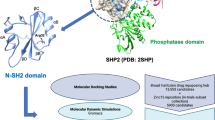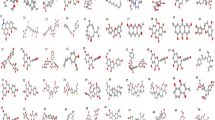Abstract
Among the most well-known members of the mitotic protein kinase family are polo-like kinases. Polo-like kinase 4 as a type of this family is used as a therapeutic target in the treatment of proliferative diseases. A three-dimensional quantitative structure activity relationship study with comparative molecular field analysis and comparative molecular similarity indices analysis was carried out on a data set of 47 molecules consisting of (E)-3-((1H-indazol-6-yl)methylene) indolin-2-ones derivatives of polo-like kinase 4 inhibitors to rational design of new drug. The validity of model was tested with a data set divided into training and test set. All constructed models show good statistical reliability in terms of predicting polo-like kinase inhibitory activity of the molecules, based on molecular property fields like steric, electrostatic, hydrophobic, hydrogen bond donor and hydrogen bond acceptor fields. Moreover, molecular docking with CDOCKER algorithm was done to investigate interactions of between ligand and protein and to achieve bioactive ligand conformer. The energy difference between the highest occupied molecular orbital and the lowest unoccupied molecular orbital (gap) implicitly stated the high reactivity of the most active molecule in the active site of protein. Furthermore, the molecular electrostatic potential energy at density functional theorylevel confirm the results from molecular docking. The identified key features obtained from the quantitative structure activity relationship modeling enabled us to design novel indolinone derivatives. In silico absorption, distribution, metabolism and excretion and toxicity risk assessment analyses were carried out on the new molecules to investigate compliance with the standard ranges.







Similar content being viewed by others
References
Barr FA, Silljé HH, Nigg EA (2004) Polo-like kinases and the orchestration of cell division. Nat Rev Mol Cell Biol 5(6):429–441
Basto R, Brunk K, Vinadogrova T, Peel N, Franz A, Khodjakov A, Raff JW (2008) Centrosome amplification can initiate tumorigenesis in flies. Cell 133(6):1032–1042
Bettencourt-Dias M, Hildebrandt F, Pellman D, Woods G, Godinho SA (2011) Centrosomes and cilia in human disease. Trends Genet 27(8):307–315
Bettencourt-Dias M, Rodrigues-Martins A, Carpenter L, Riparbelli M, Lehmann L, Gatt M, Glover D (2005) SAK/PLK4 is required for centriole duplication and flagella development. Curr Biol 15(24):2199–2207
Bornens M (2012) The centrosome in cells and organisms. Science 335(6067):422–426
Cramer RD, Patterson DE, Bunce JD (1988) Comparative molecular field analysis (CoMFA). 1. Effect of shape on binding of steroids to carrier proteins. JAm Chem Soc 110(18):5959–5967
Davis EE, Katsanis N (2012) The ciliopathies: a transitional model into systems biology of human genetic disease. Curr Opin Genet Dev 22(3):290–303
Frisch M, Trucks G, Schlegel HB, Scuseria G, Robb M, Cheeseman J, Petersson G (2009) Gaussian 09, revision A. 02, vol 19. Gaussian, Inc., Wallingford, pp 227–238
Ganem NJ, Godinho SA, Pellman D (2009) A mechanism linking extra centrosomes to chromosomal instability. Nature 460(7252):278–282
Ghasemi JB, Shiri F (2012) Molecular docking and 3D-QSAR studies of falcipain inhibitors using CoMFA, CoMSIA, and Open3DQSAR. Med Chem Res 21(10):2788–2806
Gönczy P (2012) Towards a molecular architecture of centriole assembly. Nat Rev Mol Cell Biol 13(7):425–435
Habedanck R, Stierhof Y-D, Wilkinson CJ, Nigg EA (2005) The polo kinase Plk4 functions in centriole duplication. Nat Cell Biol 7(11):1140–1146
Hudson J, Kozarova A, Cheung P, Macmillan J, Swallow C, Cross J, Dennis J (2001) Late mitotic failure in mice lacking Sak, a polo-like kinase. Curr Biol 11(6):441–446
Johnson EF, Stewart KD, Woods KW, Giranda VL, Luo Y (2007) Pharmacological and functional comparison of the polo-like kinase family: insight into inhibitor and substrate specificity. Biochemistry 46(33):9551–9563
Kaufman JJ (1979) Quantum chemical and physicochemical influences on structure–activity relations and drug design. Int J Quant Chem 16(2):221–241
Klebe G, Abraham U, Mietzner T (1994) Molecular similarity indices in a comparative analysis (CoMSIA) of drug molecules to correlate and predict their biological activity. J Med Chem 37(24):4130–4146
Kleylein-Sohn J, Westendorf J, Le Clech M, Habedanck R, Stierhof Y-D, Nigg EA (2007) Plk4-induced centriole biogenesis in human cells. Dev Cell 13(2):190–202
Kubinyi H (1993) 3D QSAR in drug design: theory methods and applications, vol 1. Springer Science & Business Media, New York
Laufer R, Forrest B, Li S-W, Liu Y, Sampson P, Edwards L, Plotnikova O (2013) The discovery of PLK4 inhibitors:(E)-3-((1H-Indazol-6-yl) methylene) indolin-2-ones as novel antiproliferative agents. J Med Chem 56(15):6069−6087
Lipinski CA, Lombardo F, Dominy BW, Feeney PJ (2012) Experimental and computational approaches to estimate solubility and permeability in drug discovery and development settings. Adv Drug Deliv Rev 64:4–17
Lüders J, Stearns T (2007) Microtubule-organizing centres: a re-evaluation. Nat Rev Mol Cell Biol 8(2):161–167
Mak T (2012) Targeting the cell cycle in cancer: TTK (MPS1) and PLK4 as novel mitotic targets, book of abstracts. In: Paper presented at the AACR 103rd annual meeting, Chicago, April 1–5
Mao Y, Li Y, Hao M, Zhang S, Ai C (2012) Docking, molecular dynamics and quantitative structure-activity relationship studies for HEPTs and DABOs as HIV-1 reverse transcriptase inhibitors. J Mol Model 18(5):2185–2198
Mason J, Wei S, Luo S, Nadeem V, Kiarash R, Huang P, Feher M (2011) Inhibition of polo-like kinase 4 as an anti-cancer strategy, book of abstracts. In: Paper presented at the AACR 102nd annual meeting, Orlando, Florida, 2–6 April 2011
Megraw TL, Sharkey JT, Nowakowski RS (2011) Cdk5rap2 exposes the centrosomal root of microcephaly syndromes. Trends Cell Biol 21(8):470–480
Momany F, Rone R (1992) Validation of the general purpose QUANTA® 3.2/CHARMm® force field. J Comp Chem 13:888
Nigg EA (2002) Centrosome aberrations: cause or consequence of cancer progression?. Nat Rev Cancer 2(11):815–825
Nigg EA (2007) Centrosome duplication: of rules and licenses. Trends Cell Biol 17(5):215–221
Nigg EA, Raff JW (2009) Centrioles, centrosomes, and cilia in health and disease. Cell 139(4):663–678
Politzer P, Kammeyer CW, Bauer J, Hedges WL (1981) Polar properties of carbon monoxide. J Phys Chem 85(26):4057–4060
Politzer P, Laurence P, Jayasuriya K (1985) Structure−activity correlation in mechanism studies and predictive toxicology. Spec Issue Environ Health Perspect 61:191
Politzer P, Murray JS (2002) The fundamental nature and role of the electrostatic potential in atoms and molecules. Theor Chem Acc 108(3):134–142
Pomelli CS, Tomasi J, Barone V (2001) An improved iterative solution to solve the electrostatic problem in the polarizable continuum model. Theor Chem Acc 105(6):446–451
Smith BM, Gemperline PJ (2002) Bootstrap methods for assessing the performance of near‐infrared pattern classification techniques. J Chemom 16(5):241–246
Tropsha A, Gramatica P, Gombar VK (2003) The importance of being earnest: validation is the absolute essential for successful application and interpretation of QSPR models. QSAR Comb Sci 22(1):69–77
Van de Waterbeemd H, Gifford E (2003) ADMET in silico modelling: towards prediction paradise?. Nat Rev Drug Discov 2(3):192–204
Varetto U (2009) Molekel 5.4. 0.8. Swiss National Supercomputing Centre, Manno
Author information
Authors and Affiliations
Corresponding author
Ethics declarations
Conflicts of interest
The authors declare that they have no conflicts of interest.
Electronic supplementary material
Rights and permissions
About this article
Cite this article
Shiri, F., Rakhshani-morad, S., Samzadeh-kermani, A. et al. Computer-aided molecular design of some indolinone derivatives of PLK4 inhibitors as novel anti-proliferative agents. Med Chem Res 25, 2643–2665 (2016). https://doi.org/10.1007/s00044-016-1638-3
Received:
Accepted:
Published:
Issue Date:
DOI: https://doi.org/10.1007/s00044-016-1638-3




